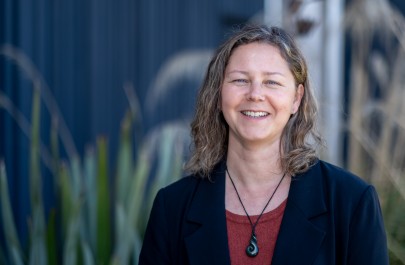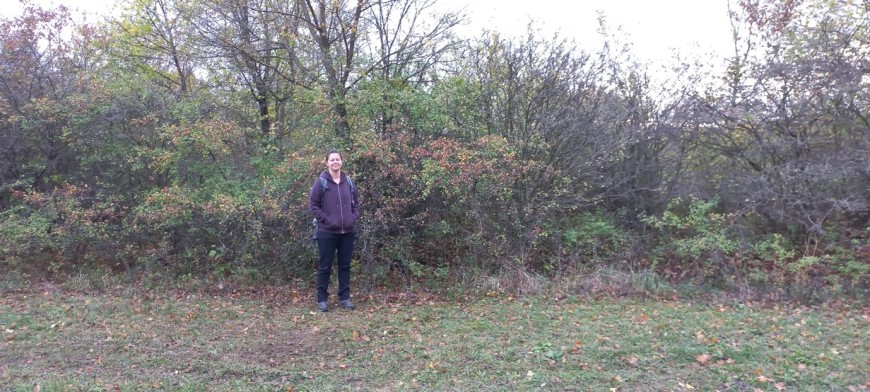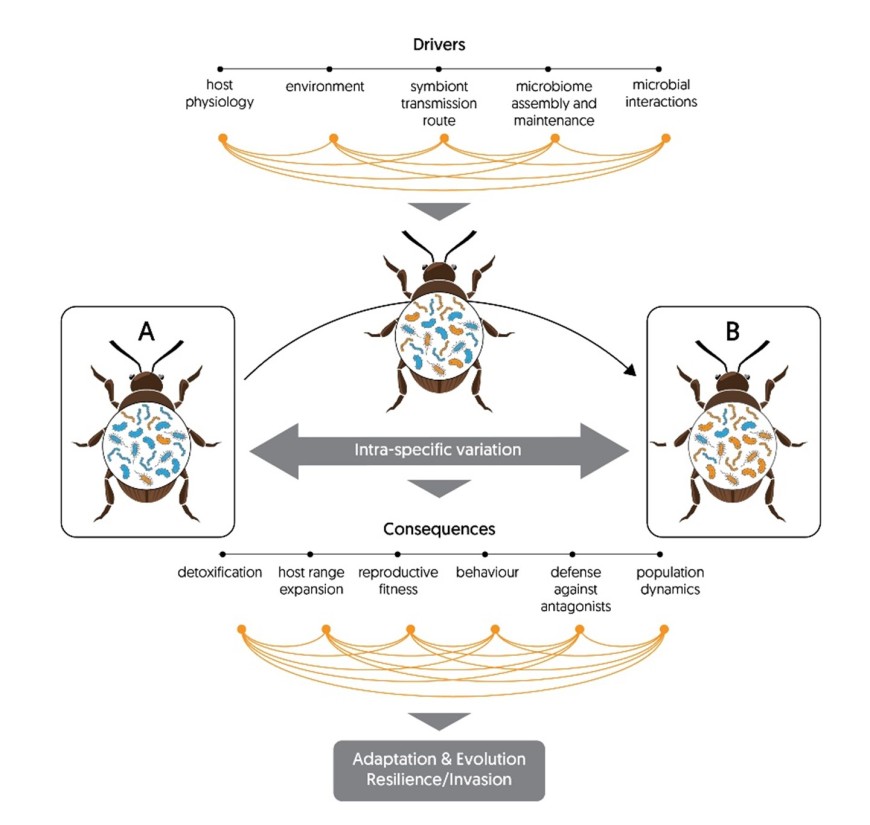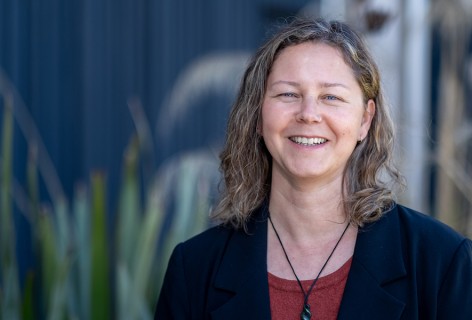Focusing on the Insect Microbiome

Claudia Lange
Molecular biologist Claudia Lange is currently leading two areas of research related to insect microbiomes. The first involves investigating the effects of gut microbes on insect performance across native and introduced ranges. This research was prompted by the discovery in 2008 of a small population of St John’s wort beetles that appeared to be persisting on a population of native Hypericum species (a mix of mainly H. involutum with some H. rubicundulum). St John’s wort beetles (Chrysolina hyperici and C. quadrigemina) were released as biocontrol agents for this weed in New Zealand between the 1940s and 1960s.
St John’s wort (Hypericum perforatum) is an invasive pasture weed in New Zealand and in many other countries beyond its native range of Europe and North Africa, and St John's wort beetles are highly effective biocontrol agents. Best-practice host-specificity testing at the time the beetles were released in many parts of the invaded range was focused on crop species and neglected to test closely related native hosts. Retrospective tests in 2008/09 have shown that the native plant species are indeed within the fundamental host range of the beetles, which can complete development on H. involutum in the laboratory just as well as they do on St John’s wort. Yet populations of H. involutum in nature do not appear to be under attack, other than this one small population discovered in 2008. This led to the question of whether changes to the microbiome have enabled the beetles to persist on the native H. involutum at that one site, and what this could mean for the long-term safety and effectiveness of weed biocontrol agents.
Claudia and her team will use genetic profiling to identify microbial taxa that are specific to the insect and to the host plant, comparing European and New Zealand insect and plant specimens. The knowledge we gain from this project will be valuable for understanding the potential for host range shifts and associated biological risks posed by other herbivorous insects introduced into novel environments to control invasive weeds.
Another major goal of this project is to establish a productive collaboration with the Max Planck Institute for Chemical Ecology in Jena, Germany. The institute is one of 86 institutes of the Max Planck Society, Germany's most successful research organisation. Claudia is working closely with the director of the Department of Insect Symbiosis, Professor Martin Kaltenpoth, whose research focuses on the molecular basis, ecological impact, and evolutionary history of symbiotic associations between insects and beneficial microbes. Claudia also aims to establish links with other organisations to co-develop research agendas relevant to biosecurity, biodiversity, biocontrol and conservation in the longer term.
In 2022 Claudia visited the Max Planck Institute for a 2-month research stay. This visit allowed her to collect samples of St John’s wort beetles in their native range, and to analyse them in world-class laboratories with advice from her new insect symbiosis colleagues. The extended visit was an excellent opportunity to meet experts, attend seminars and learn new skills. Claudia also made connections with an agricultural co-operative that commercially grows medicinal herbs. St John’s wort has been used as a medicinal herb for centuries for treating mental health conditions, and so they were very interested in better ways to control St John’s Wort beetles, which for them are a pest.

Image: Claudia and St. John’s wort in Germany.
Back in New Zealand, Claudia is collecting beetles from St John’s wort and native Hypericum species to compare their microbiomes among different host plants and with the microbiomes of beetles collected from St John’s wort in Germany. There will be further research exchanges between Germany and New Zealand in the coming year, which may also involve research on other leaf beetles, such as New Zealand endemic beetles in the subfamily Chrysomelinae, and European pest species in New Zealand such as the mint leaf beetle (Chrysolina herbacea).
The second aspect of Claudia’s research is looking at the impact of intraspecific variation in insect microbiomes on host phenotype and evolution. This is an ‘Outside Thinking – Brilliant Writing’ initiative, which aims to establish a new international collaboration and produce a synthesis paper about the development of a new research agenda. A group of six Manaaki Whenua – Landcare Research (MWLR) researchers from the Biocontrol & Molecular Ecology team were interested in increasing understanding of the impact of insect microbiomes on the hosts and the environment.
In 2021 the researchers (led by Claudia) facilitated a discussion session ‘Implications of switching invertebrate microbiomes on interactions with plants’ at the Symposium on Insect–Plant Interactions (Leiden, The Netherlands) to explore the interest of the international research community. Over 50 delegates attended the discussion, and the majority emphasised the need to investigate the functional impacts of changed microbiomes on species interactions. The international consensus was that integrated research approaches are needed as the next logical step to improve the management of invasive insects. Five of the delegates joined our team to work collaboratively on research ideas, publications and funding proposals. For a year Claudia and the team had regular meetings with international collaborators.
When Claudia was awarded the ‘Outside Thinking – Brilliant Writing’ funding in 2022 the group were already well prepared to start working on the synthesis paper. Most of the planning and writing were done by Zoom meetings, but some team members were also able to travel to Europe to meet in person. During Claudia’s trip to Europe in 2022 she visited the French, German, Swiss and Dutch collaborators. One French collaborator was also able to travel to New Zealand to attend one of our two paper-writing workshops in person.
The review paper identifies a lack of understanding of how intraspecific variation in the assembly and function of insect-associated microbial communities can shape plasticity in insects. The paper highlights that most research focuses on the core microbiome associated with a species of interest and ignores intraspecific variation (variation between individuals of the same species). The authors argue that microbiome variation among insects can be an important driver of evolution, and provide examples of how such variation can influence the fitness and health of insects, insect invasions, their success and persistence in new environments, and their responses to global environmental change.

Image: schematic diagram of insect microbiome effects.
Their schematic diagram illustrates the complexity of interacting factors, where A and B are two stages of an individual insect or a population of the same species. The drivers (host physiology, environment, symbiont transmission route, microbiome assembly and maintenance, and microbial interactions) lead to a shift in the insect-associated microbial community, which has consequences for the host (for example, detoxification, host range expansion, reproductive fitness, behaviour, defence against antagonists, and population dynamics). This complex interplay of consequences has effects on insect adaptation and evolution, and influences insect population resilience or invasion.
This demonstrates how important it is for us to understand the insect microbiome and its role in the safety and effectiveness of weed biocontrol agents. For this reason it is currently a priority area of research for our Biocontrol & Molecular Ecology team at MWLR. Claudia’s research group have submitted their synthesis paper as a foundation for this area of research and are currently addressing referee comments.
Contact

